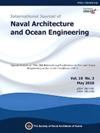Numerical and experimental investigation of an Inertial Tilting hybrid wave energy converter for powering small-scale marine systems
IF 3.9
3区 工程技术
Q2 ENGINEERING, MARINE
International Journal of Naval Architecture and Ocean Engineering
Pub Date : 2025-01-01
DOI:10.1016/j.ijnaoe.2025.100658
引用次数: 0
Abstract
The increasing global demand for marine resource exploration, maritime rights protection, and deep-sea engineering applications highlights the need for the diversification of marine engineering equipment and the expansion of its deep-sea capabilities, presenting significant technical and economic value. As the use of small-scale marine engineering equipment in deep-sea environments becomes more prevalent, optimizing energy supply methods for such equipment is critical to ensure their durability and efficiency in complex marine conditions. This paper proposes an Inertial Tilting Electromagnetic-Triboelectric Hybrid Energy Converter (ITHEC), which efficiently harvests energy from ocean waves to power small marine engineering devices. A comprehensive design and optimization framework was developed for this energy converter. This framework was based on theoretical analysis and simulations of structural dynamics and characteristics. Validation experiments were conducted using a custom-built structural characteristics testing platform. The results showed that under horizontal harmonic motion excitation with an amplitude of d = 60 mm and a frequency of f = 1.5Hz, the open-circuit voltages of the triboelectric nanogenerator (TENG) and electromagnetic generator (EMG) reached 60V and 0.23V, respectively, with short-circuit currents of 1.3 μA and 2.2 mA, and peak power densities of 1.18 mW/m2 and 0.51 mW/m2. When arrayed, the hybrid energy converter can meet the operating current requirements of small marine sensors. This study offers an innovative solution for energy supply challenges in small marine equipment and establishes the practical viability of hybrid power systems for marine energy harvesting.
小型海洋系统惯性倾斜混合波能转换器的数值与实验研究
全球对海洋资源勘探、海洋权益保护和深海工程应用的需求日益增长,凸显了海洋工程设备多样化和深海能力扩展的需求,呈现出重大的技术和经济价值。随着小型海洋工程设备在深海环境中的使用越来越普遍,优化此类设备的能源供应方法对于确保其在复杂海洋条件下的耐久性和效率至关重要。本文提出了一种惯性倾斜电磁-摩擦电混合能量转换器(ITHEC),它可以有效地从海浪中收集能量,为小型海洋工程设备提供动力。建立了该能量转换器的综合设计与优化框架。该框架基于理论分析和结构动力学特性仿真。在定制的结构特性测试平台上进行了验证实验。结果表明,在幅值为d = 60 mm、频率为f = 1.5Hz的水平谐波激励下,摩擦纳米发电机(TENG)和电磁发电机(EMG)的开路电压分别达到60V和0.23V,短路电流分别为1.3 μA和2.2 mA,峰值功率密度分别为1.18 mW/m2和0.51 mW/m2。混合能量转换器阵列后,可以满足小型船用传感器的工作电流要求。该研究为小型船舶设备的能源供应挑战提供了一种创新的解决方案,并建立了用于海洋能源收集的混合动力系统的实际可行性。
本文章由计算机程序翻译,如有差异,请以英文原文为准。
求助全文
约1分钟内获得全文
求助全文
来源期刊

International Journal of Naval Architecture and Ocean Engineering
ENGINEERING, MARINE-
CiteScore
4.90
自引率
4.50%
发文量
62
审稿时长
12 months
期刊介绍:
International Journal of Naval Architecture and Ocean Engineering provides a forum for engineers and scientists from a wide range of disciplines to present and discuss various phenomena in the utilization and preservation of ocean environment. Without being limited by the traditional categorization, it is encouraged to present advanced technology development and scientific research, as long as they are aimed for more and better human engagement with ocean environment. Topics include, but not limited to: marine hydrodynamics; structural mechanics; marine propulsion system; design methodology & practice; production technology; system dynamics & control; marine equipment technology; materials science; underwater acoustics; ocean remote sensing; and information technology related to ship and marine systems; ocean energy systems; marine environmental engineering; maritime safety engineering; polar & arctic engineering; coastal & port engineering; subsea engineering; and specialized watercraft engineering.
 求助内容:
求助内容: 应助结果提醒方式:
应助结果提醒方式:


